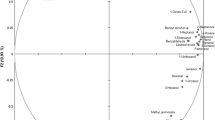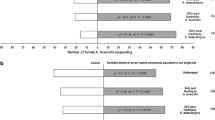Summary
Feeding by the homopteranPsylla pyricola on leaves of pear trees induces the production of volatile compounds, such as (E,E)-α-farnesene and methyl-salicylate, as well as the production of polyphenols. The inference on induction is based on GC-MS and HPLC chromatograms from the same samples ofPsylla infested leaves, leaves from the same pear tree beforePsylla infestation and uninfested leaves from other pear trees.Psylla infestation greatly enhanced the production of volatiles ((E,E)-α-farnesene, methyl-salicylate and others) and triggered the production of new polyphenols, characterized by much longer retention times.
However, the responses to infestation depend critically on leaf age (defined by leaf distance to apex). With respect to the leaf volatiles it appears that infested, old leaves produce fewer compounds and lower amounts of the volatiles than infested, young leaves. Moreover, there seem to be differences in pattern. Relative to (E,E)-α-farnesene, methyl-salicylate was found in much lower amounts in heavily infested, old leaves. With respect to polyphenols it was found that infested old leaves collected in August have polyphenols with the same retention times, but more or less equal amounts as uninfested young leaves collected in May. This shows thatPsylla infestation causes the induced response mostly in young leaves.
The induced leaf volatiles may act as synomones to heteropteran bugs. As shown elsewhere,Anthocoris nemoralis responds significantly to (E,E)-α-farnesene and methyl-salicylate when offered in pure form against clean air in a Y-tube olfactometer. The effect of polyphenols on the performance ofP. pyricola is not yet known. Hence, a role in direct defence is still to be investigated.
Similar content being viewed by others
References
Dicke M, Sabelis MW (1988) How plants obtain predatory mites as bodyguards. Neth J Zool 38:148–165
Dicke M, van Beek TA, Posthumus MA, Ben Dom N, van Bokhoven H, de Groot Æ (1990) Isolation and identification of volatile kairomone that affects acarine predator-prey interactions. J Chem Ecol 16:381–396
Drukker B, Sabelis MW (1990) Anthocorid bugs respond to odours emanating fromPsylla-infested pear trees. Proc Exper & Appl Entomol, NEV Amsterdam 1:88–89
Drukker B, Scutareanu P, Sabelis MW (1995) Do anthocorid predators respond to synomones fromPsylla-infested pear trees under field conditions? Entomol exp appl 77:193–203
Fisk J (1980) Effects of HCN, phenolic acids and related compounds inSorghum bicolor on the feeding behaviour of the planthopperPeregrinus maidis. Entomol exp appl 27:211–222
Hardie J, Isaacs R, Pickett JA, Wadhams LJ, Woodcock CM (1994) Methyl salicylate and ( −)-(1R,5S)-myrtenal are plant-derived repellents for black bean aphid,Aphis fabae Scop. (Homoptera: Aphididae). J Chem Ecol 20: 2847–2855
Matias C, Vilas Boas L, Nguyen TX, Melo I (1990) Rélation entre la sensibilité aux ravageurs de differents cultivars de poirier et leur composition chimique. Colloque “Protection integré en vergers de poirier”
Miller RL, Bills DD, Buttery RG (1989) Volatile components from Bartlett and Bradford pear leaves. J Agric Food Chem 37:1476–1479
Niemann GJet al. (1992) Phytoalexins, benzoxazinons, N-Aroylanthranilates and N-Aroylanilins, fromFusarium-infected carnation stems. Phytochemistry 31:3761–3767
Price PW (1986) Ecological aspects of host plant resistance and biological control: interactions among three trophic levels. Pp 11–30in Boetthel DJ, Eikenbary RD (eds) Interactions of Plant Resistance and Parasitoids and Predators of Insects. GB-Chichester: Ellis Horwood
Scutareanu P, Schoffelmeer E (1994) A preliminary experiment to detect induced phenolic compounds inPsylla-infested pear trees. Med Fac Landbouww Univ Gent 59/2b:681–683
Scutareanu P, Sabelis MW, Boon JJ, van der Hage E, Grove A (1994) Leaf polyphenols in pear trees infested byPsylla pyricola or mechanically damaged. “Polyphenols '94”, Palma de Mallorca (Spain), May 23–27:373–374
Tallamy DW, Raupp MJ (eds) (1991) Phytochemical Induction by Herbivores. New York: John Wiley & Sons
Author information
Authors and Affiliations
Rights and permissions
About this article
Cite this article
Scutareanu, P., Drukker, B., Bruin, J. et al. Leaf volatiles and polyphenols in pear trees infested byPsylla pyricola. Evidence of simultaneously induced responses. Chemoecology 7, 34–38 (1996). https://doi.org/10.1007/BF01240635
Issue Date:
DOI: https://doi.org/10.1007/BF01240635




